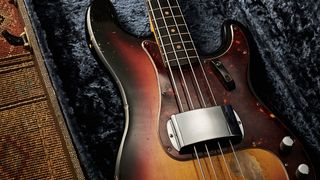Looking back, it could be argued that no other Fender design has had as significant a cultural impact as the Precision Bass. Appearing in late 1951, it wasn’t just a new model – as far as most people were concerned it was a new type of instrument altogether.
This horizontal, fretted, solidbody electric bass guitar changed the course of music almost single-handedly. From the dancehall bands of the early ’50s to contemporary electronic dance music, the P-Bass’s legacy is evident.
Sure, there were other electric basses that came before it (produced by manufacturers such as Tutmarc and Rickenbacker), but none that were well designed enough to alter the way modern music was written and performed.
Infinitely more convenient and easier to play than the ubiquitous double basses that came before it, and with the ability to be clearly heard at virtually any volume without feeding back, the Fender P-Bass punched its way to the top, leaving what little competition there was in the dust.

The Precision Bass was launched mere months after its six-string sibling, the Esquire – Fender’s first Spanish-style electric solidbody – was released the previous year. This original incarnation of the P-Bass bears more than a passing resemblance to the Esquires and Broadcasters/Telecasters of the early ’50s.
In fact, Fender launched a ‘reissue’ called the Telecaster Bass in 1968, modelled after its seminal design, although its white pickguard (not to mention the rare Paisley Red and Blue Flower finishes!) sets it apart.

As per the Blackguard Teles from 1954 and earlier, the P-Bass in its initial guise featured an ash slab body with a blonde finish and black pickguard. And while the headstock profile was instantly recognisable as being cut from the same Fender cloth, the Precision featured a new offset double-cutaway, enabling easier access to the upper frets, while helping to balance the instrument’s weight.
This unique shape influenced the blueprint of the Stratocaster. In return, the P-Bass took on more than a few of the Strat’s design features when it was released later in ’54.
That year, the Precision began morphing from a Tele- to a Strat-style design, a similarly contoured body complete with a two-tone sunburst finish and white pickguard establishing it as the bass partner to Fender’s new flagship guitar.
Further Stratocaster-derived alterations occurred in 1957 when the headstock profile was reworked. Additionally, the instrument’s pickguard was reduced in length away from the bass horn and extended further into the lower treble bout area where both control knobs were now mounted – effectively replacing the Tele-style chrome control plate.
However, the most significant revision to the design of the Precision Bass that year (certainly in terms of sound) was the introduction of the humbucking split pickup, which replaced the original four-pole single-coil variety.
From this point onwards, little changed with respect to the essential design of the Precision Bass. There were, of course, some (mainly cosmetic) changes – including the introduction of a rosewood fretboard in ’59 – but the P-Basses Fender builds today are unmistakable. Much like the Tele and Strat, this winning design means it has never been discontinued.
The Evolution of the Fender Precision Bass
- Late 1951: First shipped; ash body; fretted maple neck; blonde finish; black pickguard; single-coil pickup
- Spring 1952: First advertised; 26-watt/1x15 Bassman (partner amp)
- 1954: Strat-style contoured body; 2-tone sunburst finish; white pickguard
- 1956: Alder body
- 1957: Strat-style headstock and gold pickguard; humbucking split pickup; 4-saddle bridge
- 1958: 3-tone sunburst finish
- 1959: Tortoiseshell cellulose nitrate pickguard; ‘slab’ rosewood fretboard
- 1962: Veneer rosewood fretboard
- 1967: Offered with maple fretboard
- 1968: Early 50s-style Telecaster Bass (Blonde, Paisley Red & Blue Flower finishes)
- 1970: Offered with fretted maple neck


